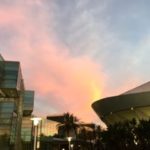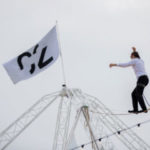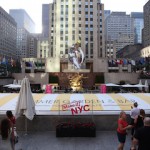
“So, what do you know about St. Louis?”
Brian Hall, chief marketing officer for Explore St. Louis, asked me this question beside a fire pit at Three Sixty STL, a rooftop restaurant at downtown’s Hilton St. Louis at the Ballpark hotel. The sun had just set, and while balancing a wine glass in one hand and a seared-tuna taco in the other, I thought about Mark Twain, Lewis and Clark, and the Gateway Arch. “Not a whole lot,” I admitted.
“Exactly,” Hall said.
By the time I left St. Louis two days later, after a visit sponsored by Explore
St. Louis, I had learned that this seemingly under-the-radar city of 318,000 people — with 2.8 million in the greater metropolitan area — brims with history, innovation, food, music, and charm.
DAY 1: Under the Arch
Of course, a river runs through it, too. St. Louis spreads along the west bank of the Mississippi, and it wasn’t long after landing at Lambert–St. Louis International Airport — a 20-minute drive or train ride from downtown — that I was standing in the windows of the CityArchRiver Foundation building, looking out on Ol’ Man River and the iconic Gateway Arch.
In the 1960s, the park grounds that surround the Gateway Arch National Monument were cut off from downtown St. Louis by a highway. Fifty years later, the CityArchRiver Foundation is guiding a $380-million renovation of the park, the Arch, and the Museum of Westward Expansion at its base. With $221 million from private sources, the project is the largest-ever private investment in a U.S. National Park. “We’ve been talking about this for decades,” said Ryan McClure, the Foundation’s communications director. “The stars just sort of aligned.”
When the CityArchRiver project is complete in late 2017, not only will the 630-foot-high Arch have a facelift, the park’s public spaces, including an amphitheater and lawns, will be revitalized. The subterranean museum — which tells the story of westward expansion — will offer 50,000 square feet of modernized space for events for up to 4,000 people. Since the project will also raise the riverfront by five feet, the Mississippi’s periodic flooding will be less of a problem. “We’re going to get a lot of days back,” McClure said.
From the Arch, it was only a short stroll to Ballpark Village, a complex of bars and restaurants adjacent to Busch Stadium, home of the city’s beloved St. Louis Cardinals. The heart of Ballpark Village is a lofty central space topped by a retractable glass roof, and around its perimeter are bars, enormous flat screens, and eateries serving everything from sushi to Southern fare. We nursed pints from St. Louis’ hometown brewery, Anheuser-Busch, while wandering Ballpark Village’s 122,000 square feet of event space, including a breezy terrace bar, the Skybox, that overlooks the field. “[The Village] can be dressed up, or it can be dressed down,” Director of Sales Jill Metherd said during a tour, with spaces for events of anywhere from six to 6,000 people.
Back outside, St. Louis’ wide avenues buzzed with impeccably dressed people, including women in elaborate hats. More than 35,000 members of the Church of God in Christ (COGIC) were in town for their annual Holy Convocation at the America’s Center Convention Complex. The country’s largest African-American Pentecostal denomination, COGIC has gathered in St. Louis every year since 2010, and last summer signed a three-year agreement to hold the Holy Convocation here — a sign of faith after recent violence in nearby Ferguson, Missouri. “St. Louis fits our needs and has proven to be a great match,” Keith Kershaw, COGIC’s director of the office of convention planning, said at the time.
Indeed, downtown’s America’s Center, with 500,000 square feet of exhibit space, is an ideal match for such a large group. The venue’s airiness is the result of a $50-million renovation in 2009. For COGIC, a red carpet stretched through the entire foyer, and a bazaar occupied one area of the 180,000-square-foot exhibit hall, which can be broken into five smaller spaces. Paige Millard, America’s Center’s vice president of event services, explained that the venue is so large that several conferences can go on concurrently without anyone stepping on each other’s toes. (Over one weekend this past January, 14 groups met there simultaneously.) And sure enough, despite the bustle of COGIC attendees on the ground floor, the halls on the second level were quiet — as was the intimate, 1,400-seat Ferrara Theater, which Keith Levey, Explore St. Louis’ director of strategic accounts, described as “perfect for medical meetings.”
But there was more. A five-minute, indoor stroll deposited us inside the Edward Jones Dome, a multipurpose venue that seats 67,000 people, and has hosted sporting events, rock concerts, and even a Mass by Pope John Paul II in 1999.
By sunset, as Hall and I had our fireside chat, the city’s subtle charisma was starting to work its magic.
DAY 2: Living History (and Hotels)

Over a hearty breakfast in my host hotel, the Marriott St. Louis Grand (headquarters hotel for America’s Center), I learned that the property has its own 58,000 square feet of meeting space, and that its 917 guest rooms were renovated to their current swanky elegance in 2015. They make up just one portion of downtown’s 7,000 rooms, a third of which were newly built or renovated in the past year.
Many of those rooms are in the city’s handsome 19th-century buildings, each with its own story. The Marriott, for example, was built in 1917 as the Hotel Statler, and was the first air-conditioned hotel in the United States. A block away, the 182-room boutique Magnolia Hotel, including a dramatically lit lobby bar and 8,000 square feet of meeting space, evokes flapper style; during its days as the Mayfair Hotel, Cary Grant and Douglas Fairbanks slept there. Nearby, the cozy, 165-room Courtyard by Marriott Downtown Convention Center opened in 2015 inside the former Lennox Hotel, with a direct connection to America’s Center. Within walking distance, the Hilton St. Louis at the Ballpark offers location, location, location — 100 yards from Busch Stadium and a block from the Gateway Arch, with 675 rooms and 40,000 square feet of meeting space. Even closer to the Arch is the Hyatt Regency St. Louis at The Arch, with 910 guest rooms and suites, plus 83,000 square feet of meeting space and a rooftop garden.
For sheer novelty, it’s hard to top the St. Louis Union Station – a DoubleTree by Hilton Hotel. After it opened in 1894, Union Station was the largest, busiest rail station in the world. Now a National Historic Landmark, the station is home to both a mall and the 537-room DoubleTree, whose soaring lobby has a room-length bar, an hourly light-and-sound show about the building’s history, and 100,000 feet of meeting space, some of it opening into the former train shed.
For lunch, we decamped to the sleek Cielo at the Four Seasons St. Louis for butcher boards of cured meats, grilled octopus, and roasted veggies with cloudlike burrata. This five-star, 200-room hotel epitomizes urban chic, and has 20,000 square feet of meeting space and stunning views of the river and Gateway Arch.
If our hotel tour provided a taste of St. Louis’ historic architecture, an equally whirlwind spin through the city’s neighborhoods showed off its livability. Our easygoing guide, native St. Louisan Judi Beheler, narrated the stories behind trendy neighborhoods such as Maplewood and Soulard — full of funky shops and restaurants — and the Central West End, where we grabbed a hot chocolate at Bissinger’s. The highlight of the tour: the Cathedral Basilica of Saint Louis. Opened in 1914, the cathedral seems to glow from within, literally, thanks to an interior covered in 41 million gold tesserae.
Among the many Fortune 500 companies that call St. Louis home, Anheuser-Busch might be the best known. Visiting the brewery is sort of like experiencing Wonka’s Chocolate Factory of beer — and tours are a thrill for Budweiser lovers. We paid a quick visit to the company’s famous Clydesdale horses, lazily chewing hay inside their stalls.
We’d already packed a lot into one day, but St. Louis’ bustling nightlife beckoned. Restaurants and clubs cluster in the riverside Laclede’s Landing neighborhood, as well as along Washington Avenue — where a new National Blues Museum will open in April, with 15,000 square feet of exhibit, classroom, and theater space that tells the story of the American blues. We traveled still farther afield for dinner, to Lafayette Square and the quaint Eleven Eleven Mississippi, whose kitchen serves up “new Tuscan” plates such as wild-boar ravioli. Despite the ensuing food coma, our group rallied to hear live music at Jazz at the Bistro, where Poncho Sanchez and his band were wrapping up a set.
DAY 3: All About Innovation
History, music, food — what more could you want in a destination? In St. Louis, innovation is also a vital part of the city’s identity. For decades, St. Louis has been home to powerful education, scientific, and medical sectors, but it wasn’t until 15 years ago that the city began to build on those strengths through collaboration and strategic partnerships.
First stop: T-REX, a funky, 160,000-square-foot coworking space and incubator in downtown St. Louis. Co-founder Alex Haimann explained how T-REX — home to 110 startups — puts budding entrepreneurs in proximity to each other “to help ideas germinate.” T-REX’s free beer and coffee, as well as a portion of its capital, are supplied by some of the city’s more established companies.

BioSTL is another outgrowth of St. Louis’ focus on innovation, albeit one with a different feel. Inside its polished offices, President and CEO Donn Rubin explained how St. Louis once had “zero” entrepreneurial infrastructure. BioSTL, a consortium of local leaders brought together by William Danforth, M.D., retired chancellor of Washington University in St. Louis, has helped build regional infrastructure, market
St. Louis’ sciences, attract new talent, and improve access to capital.
BioSTL spurred a handful of research centers, and also attracted the first expansion of the Cambridge Innovation Center outside Massachusetts. CIC, a hive of startup workspaces, has an open-plan central area that can be rented for special events — as can its Venture Café, where entrepreneurs mingle with the public during weekly events.
Within the hour, we were touring the greenhouse labs of the Donald Danforth Plant Science Center, a shimmering, modern complex where plants are developed that might provide energy, or resist drought or disease. “We like to think of plants as factories,” Karla Roeber, the center’s vice president of public and government affairs, said during a tour. The center’s atrium, terrace, and 300-seat AT&T Auditorium all can host private events.
The brisket and ribs at Sugarfire Smoke House, one of the city’s more famous barbecue joints, provided necessary sustenance before we came face-to-face with the nonstop action at ExpressScripts, the nation’s largest provider of prescriptions. As pharmaceutical bottles of all shapes and sizes spun by on conveyor belts — as they do 24 hours a day — it was hard not to think that the Gateway City is still exploring the frontier, albeit in entirely 21st-century ways.
Soon, I was back at the airport, waiting for my flight home. The 48 hours I spent in St. Louis were as much as a whirlwind as they possibly could be — but still, I had the nagging sense that I’d only grazed the surface of this multifaceted place. There seems to be so much more to explore in this truly American city, one whose future seems as rich and vital as its past. Fortunately, it’s only a three-hour flight away.




